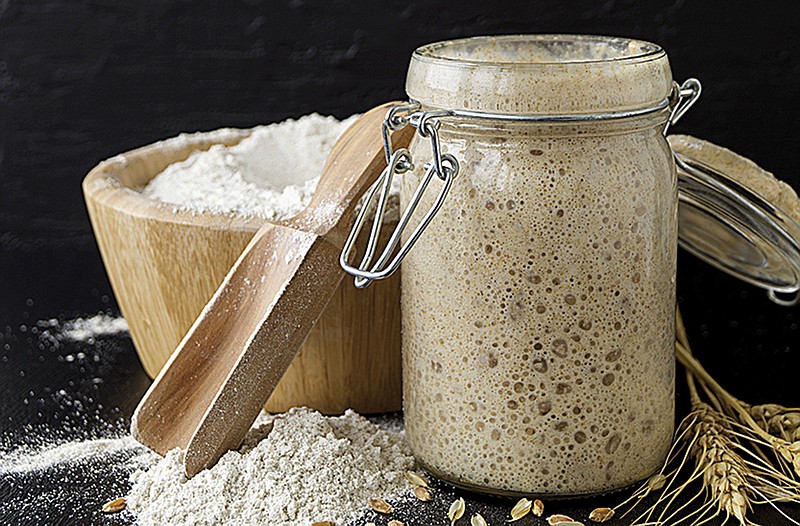Much is uncertain in these uncertain times, and one of those things is the availability of some items at the grocery store.
When the coronavirus panic first hit, flour and yeast flew off the shelves like they were toilet paper. Everyone seemed to decide at once that if they were going to be home, they might as well bake some bread.
The availability of eggs has been spotty, too, as well as butter. There have been blank spaces in some sections of the produce department. At the beginning of the panic, stores sold out of garlic, which I can't begin to understand.
Flour, yeast, butter and garlic. Was everybody making garlic bread?
Fortunately, the supply chain has mostly caught up with demand, or perhaps demand has slowed down until the supply chain could catch up with it. But there is always a nagging question or two when you go to the grocery store: Will it be out of something I need?
Yeast is all around us, floating in the air. When ancient Romans, for instance, baked bread, they did not go to their local Shop 'n' Spend and buy a three-pack of Fleishmann's. They mixed flour with water and waited for the yeast in the air and on the flour to react, which allowed the bread to rise.
You can do the same thing at home.
As I write this, I am making a fourth attempt - this one following the instructions from King Arthur Flour. I cannot personally vouch for the recipe (yet), but on the assumption that it works we've provided a recipe.
Sourdough Starter
1 cup whole wheat or rye flour (or just use 1 more cup all-purpose flour)
8 cups all-purpose flour or more
Water
Note: If at any time the starter begins to dry out, simply mix in a little bit of water. If you used only all-purpose flour, your starter may take a little longer to get going.
1. Combine 1 cup whole wheat, rye or all-purpose flour with 1/2 cup cool water (lukewarm water if your house is cold) in a 1-quart or larger nonreactive container, such as glass, crockery, stainless steel or food-grade plastic. Cover loosely and let sit at warm room temperature, about 70 degrees, for 24 hours.
2. You may see no activity at all in the first 24 hours, or there may be some bubbling or growth in size. Either way, weigh out 4 ounces of the mixture, about 1/2 cup, and discard the rest - not down the sink or through other plumbing. Add 1 cup of all-purpose flour and 1/2 cup of cool water (lukewarm if your house is cold). Mix, cover loosely and let sit at warm room temperature for 24 hours.
3. By the third day, you'll likely see some activity - bubbling; a fresh, fruity aroma, and some evidence of expansion. It's now time to begin two feedings daily, as evenly spaced as your schedule allows. For each feeding, weigh out 4 ounces of starter (a generous 1/2 cup) and discard the rest. Stir in 4 ounces (a scant 1 cup) of all-purpose flour and 1/2 cup of cool (or lukewarm) water.
4. Repeat the process on the fourth and fifth days, feeding the starter every 12 hours.
5. By the end of the fifth day, the starter should have doubled in volume, with lots of bubbles and a tangy aroma. If it hasn't risen sufficiently and does not have enough bubbles, repeat the every-12-hour feedings until the starter is risen and bubbly.
6. Once the starter is ready, give it one last feeding. Discard all but 4 ounces (a generous 1/2 cup). Feed as usual. Let the starter rest at room temperature for 6 to 8 hours; it should be active, with bubbles breaking the surface.
7. Remove however much starter you need for your recipe - typically no more than 8 ounces, about 1 cup. If your recipe calls for more than 1 cup of starter, give it a couple of feedings without discarding, until you've made enough for your recipe plus 4 ounces to keep and feed again.
8. Transfer the remaining 4 ounces of starter to its permanent home: a crock, jar or whatever you'd like to store it in long-term. Feed this reserved starter with 1 cup of flour and 1/2 cup water, and let it rest at room temperature for several hours, to get going, before covering it. If you're storing starter in a screw-top jar, screw the top on loosely rather than airtight.
9. Store this starter in the refrigerator, and feed it regularly with a scant 1 cup flour and 1/2 cup water once a week. The starter can be kept indefinitely in this manner.
Recipe by King Arthur Flour

